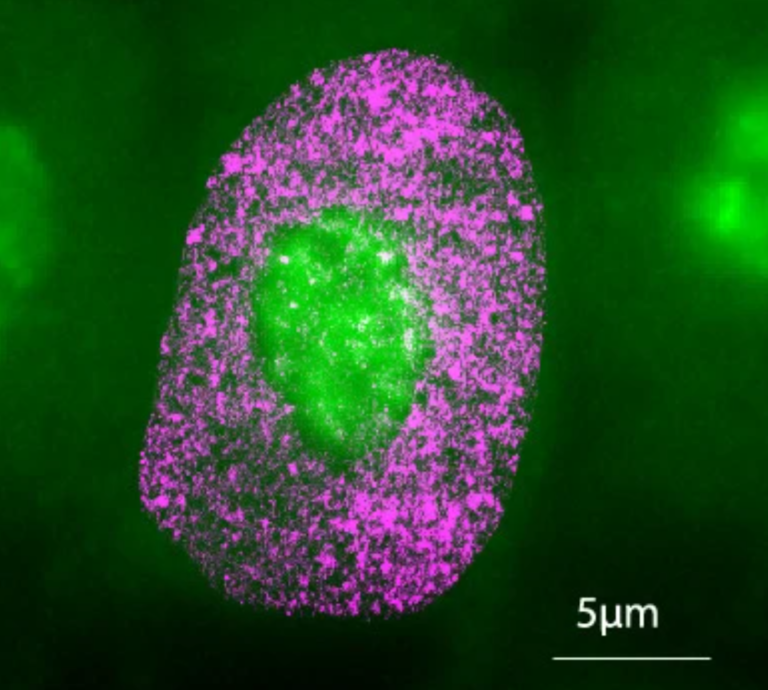A joint team of researchers from institutions such as the Center for Genome Regulation (CRG), the University of the Basque Country (UPV/EHU), the Donostia International Physical Center (DIPC), and the Biscaia Biological Foundation (FBB) has made significant advances in disease diagnosis . Through artificial intelligence (AI).
Their recent research, published in Nature Machine Intelligence, reveals a new AI tool, AINU (AI of the NUcleus), that can distinguish between cancerous and normal cells and detect the early stages of viral infection. This advancement could lead to better diagnostic techniques and new disease monitoring strategies, leading to improvements in healthcare.
AINU works by scanning high-resolution images of cells obtained using a specialized microscopy technique called STORM (Stochastic Optical Reconstruction Microscopy). Unlike regular microscopes, STORM captures details of cellular structures at the nanoscale level. To put this scale into perspective, one nanometer (nm) is equivalent to one billionth of a meter, and the width of a human hair is approximately 100,000 nm.
Super resolution image of HeLa cancer cells. The image uses two colors to show specific nuclear components, allowing researchers to see detailed structures within the cell nucleus at nanoscale resolution. (Credit: Limei Zhong)
AINU can detect cellular changes as small as 20 nm, which is 5,000 times smaller than the width of a human hair. These minute changes, often too subtle for traditional methods, can be identified through AI’s advanced image analysis.
Pia Kozma, CRG co-corresponding author and ICREA research professor, explains: This ability could one day give doctors valuable time to monitor disease, personalize treatment, and improve patient outcomes. ”
The AI model AINU belongs to the category of convolutional neural networks and is an AI architecture particularly suited to processing visual data such as images. Such networks are commonly found in tools such as facial recognition software and systems that allow self-driving cars to identify objects on the road. In the medical field, similar AI models assist doctors by analyzing scans such as mammograms and MRIs to identify signs of disease that may be missed by the human eye.
AINU functions by detecting and analyzing the fine structure inside cells, centering on the nucleus. The researchers trained the AI by feeding it nanoscale-resolution images of different cell types and conditions. This allowed the model to learn how nuclear components are distributed and organized in three dimensions, which could then be used to classify cells based on observed nuclear features.
For example, cancer cells often exhibit distinct changes in nuclear structure, including changes in DNA organization and enzyme distribution. After training, AINU was able to scan new cell images and accurately determine whether they were cancerous or normal based solely on these features.
Its accuracy goes beyond cancer detection, with AINU identifying changes as early as one hour after cells are infected with herpes simplex virus type 1. These early detection capabilities stem from AI’s ability to recognize subtle changes in DNA density, a hallmark of viral activity that alters cellular structure.
AINU trained on Pol II and H3 images accurately identifies somatic cells and iPSCs. (Credit: Nature Machine Intelligence)
Ignacio Arganda Carreras, co-corresponding author and Ikerbasque researcher at UPV/EHU, said: “Our method can detect virus-infected cells as soon as the infection begins. Doctors usually rely on visible symptoms or major changes in the body, so it takes longer to detect an infection. Masu.
However, with AINU, we can immediately see small changes in the cell nucleus. “Such rapid detection will help researchers better understand how the virus interacts with cells immediately after infection, which could help develop more effective treatments and vaccines,” he said. He added that there is a possibility.
Limei Zhong, co-first author of the study and researcher at Guangdong Provincial People’s Hospital, shared the vision for clinical use, saying: Processing is faster and more accurate. ”
AINU, trained on DNA images, accurately identifies different cell states. (Credit: Nature Machine Intelligence)
However, this technology faces challenges before it can be implemented in clinical practice. STORM imaging requires specialized equipment that is primarily used in laboratories, making it difficult to introduce this technology into more routine medical settings.
Furthermore, the current imaging technology used in STORM can only analyze a few cells at a time. For this tool to be effective in clinical diagnosis, doctors will need to process more cells quickly and efficiently.
Despite these hurdles, Kozma remains optimistic. “STORM imaging is rapidly advancing, and microscopy may soon become available in smaller or less specialized laboratories, and eventually in the clinic. Accessibility and throughput limitations This is a more tractable problem than previously thought, and we hope to conduct preclinical experiments soon.”
Although clinical applications may still be years away, researchers expect AINU to have a major impact on scientific research in the near term. AI can identify pluripotent stem cells with high accuracy, which can develop into any type of cell in the body. Pluripotent cells are essential for therapies aimed at repairing or replacing damaged tissue.
Occlusion-based techniques for interpretable AI. A window of the selected size (for example, 32 × 32px) is moved horizontally and vertically at specific intervals (stride) across the image tested by the model. (Credit: Nature Machine Intelligence)
Highlighting the implications for stem cell research, study lead author and CRG researcher Davide Carnevali said: “Current methods of detecting high-quality stem cells rely on animal experiments. However, the AI model needs to work in samples stained with specific markers that highlight key features of the nucleus. This not only makes it easier and faster, but also helps reduce the use of animals in science while accelerating stem cell research.”
AINU represents a breakthrough in cell analysis and offers potential advances in improving disease diagnosis and treatment strategies. Although there is still work to be done, the promise of this AI tool suggests a future in which early disease detection, personalized treatment, and efficient stem cell therapy will become more accessible and accurate.


